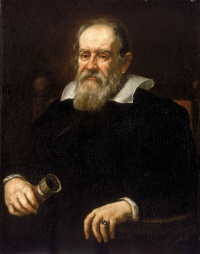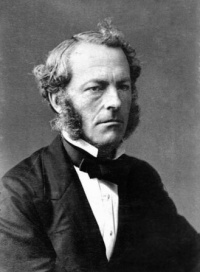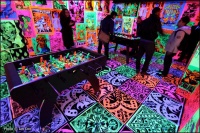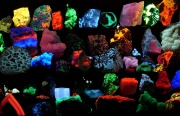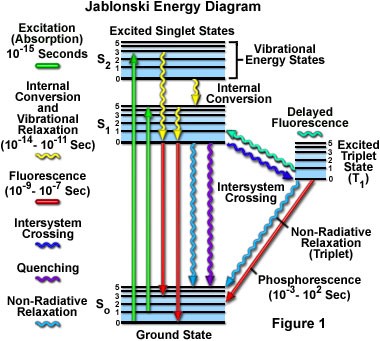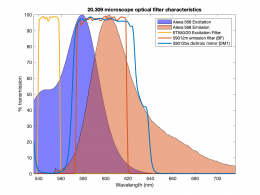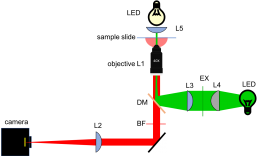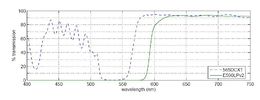Difference between revisions of "Assignment 2: fluorescence microscopy"
(→Overview) |
(→Overview) |
||
| Line 52: | Line 52: | ||
==Overview== | ==Overview== | ||
[[Image:Fluorescent minerals.jpg|right|thumb|right|Naturally fluorescent minerals exposed to ultraviolet light.]] | [[Image:Fluorescent minerals.jpg|right|thumb|right|Naturally fluorescent minerals exposed to ultraviolet light.]] | ||
| − | The [https://www.youtube.com/watch?v=9FoCIkAXYhE phenomenon] of fluorescence has beguiled both sober and inebriated witnesses since at least the [https://www.fluorescence-foundation.org/lectures%5Cmadrid2010%5Clecture1.pdf late sixteenth century]. Some of the earliest observers noticed an unusual blue tint in water that had been infused with the wood of a Mexican tree called Coatli. Other naturally-occurring fluorescent and phosphorescent materials such as Bologna Stone (baryte), fluorite, and quinine sparked considerable interest from some the most preeminent scientists. Galileo Galilei, Robert Boyle, David Brewster, John Herschel, and that trippy dude from your high school all spent time contemplating the | + | The [https://www.youtube.com/watch?v=9FoCIkAXYhE phenomenon] of fluorescence has beguiled both sober and inebriated witnesses since at least the [https://www.fluorescence-foundation.org/lectures%5Cmadrid2010%5Clecture1.pdf late sixteenth century]. Some of the earliest observers noticed an unusual blue tint in water that had been infused with the wood of a Mexican tree called Coatli. Other naturally-occurring fluorescent and phosphorescent materials such as Bologna Stone (baryte), fluorite, and quinine sparked considerable interest from some the most preeminent scientists. Galileo Galilei, Robert Boyle, David Brewster, John Herschel, and that trippy dude from your high school all spent time contemplating the nature and simple beauty of fluorescence. |
[[Image:Stokes fluorescence experiment.png|right|thumb|right|George Stokes used a prism to shine different colors of light.]] | [[Image:Stokes fluorescence experiment.png|right|thumb|right|George Stokes used a prism to shine different colors of light.]] | ||
| + | The brilliant physicist and mathemetician George Stokes conducted a particularly clever experiment in which he used a prism to separate sunlight into its component colors. As he moved a vial of quinine sulfate from color to color, Stokes noted that quinine fluoresces only when illuminated by ultraviolet light — the invisible part of the rainbow just beyond the majestic blue band. Quinine was not excited by the other colors. From this experiment, Stokes concluded that fluorescent emission has a ''longer'' wavelength than the excitation. In his honor, the difference in wavelength between the excitation and emission peak a fluorophore's spectrum is called the ''Stokes shift''. | ||
| + | |||
Stokes' observation that fluorescence depends on the color of light and not the intensity is difficult to explain using the wave model of light. George Stokes was one of the most gifted and productive scientists of all time. He was the Lucasian Professor of Mathematics at Cambridge University, and he was also elected President of the Royal Society — both positions that Isaac Newton held before him. Despite all that, it would have been nearly impossible for Stokes to come up with a good theoretical model for fluorescence. A whole new branch of physics had to be developed. Stokes died in 1903, two years before Albert Einstein addressed the discrepancy between what the wave theory predicts and what actually happens when light shines on a fluorophore or a piece of metal. The key realization was that light comes in discrete packets of energy. Aleksander Jablonski finally explained fluorescence in 1935 as a series electronic state transitions, as depicted in the Jablonski diagram. | Stokes' observation that fluorescence depends on the color of light and not the intensity is difficult to explain using the wave model of light. George Stokes was one of the most gifted and productive scientists of all time. He was the Lucasian Professor of Mathematics at Cambridge University, and he was also elected President of the Royal Society — both positions that Isaac Newton held before him. Despite all that, it would have been nearly impossible for Stokes to come up with a good theoretical model for fluorescence. A whole new branch of physics had to be developed. Stokes died in 1903, two years before Albert Einstein addressed the discrepancy between what the wave theory predicts and what actually happens when light shines on a fluorophore or a piece of metal. The key realization was that light comes in discrete packets of energy. Aleksander Jablonski finally explained fluorescence in 1935 as a series electronic state transitions, as depicted in the Jablonski diagram. | ||
Revision as of 14:55, 18 August 2017
|
|
|
|---|
Overview
The phenomenon of fluorescence has beguiled both sober and inebriated witnesses since at least the late sixteenth century. Some of the earliest observers noticed an unusual blue tint in water that had been infused with the wood of a Mexican tree called Coatli. Other naturally-occurring fluorescent and phosphorescent materials such as Bologna Stone (baryte), fluorite, and quinine sparked considerable interest from some the most preeminent scientists. Galileo Galilei, Robert Boyle, David Brewster, John Herschel, and that trippy dude from your high school all spent time contemplating the nature and simple beauty of fluorescence.
The brilliant physicist and mathemetician George Stokes conducted a particularly clever experiment in which he used a prism to separate sunlight into its component colors. As he moved a vial of quinine sulfate from color to color, Stokes noted that quinine fluoresces only when illuminated by ultraviolet light — the invisible part of the rainbow just beyond the majestic blue band. Quinine was not excited by the other colors. From this experiment, Stokes concluded that fluorescent emission has a longer wavelength than the excitation. In his honor, the difference in wavelength between the excitation and emission peak a fluorophore's spectrum is called the Stokes shift.
Stokes' observation that fluorescence depends on the color of light and not the intensity is difficult to explain using the wave model of light. George Stokes was one of the most gifted and productive scientists of all time. He was the Lucasian Professor of Mathematics at Cambridge University, and he was also elected President of the Royal Society — both positions that Isaac Newton held before him. Despite all that, it would have been nearly impossible for Stokes to come up with a good theoretical model for fluorescence. A whole new branch of physics had to be developed. Stokes died in 1903, two years before Albert Einstein addressed the discrepancy between what the wave theory predicts and what actually happens when light shines on a fluorophore or a piece of metal. The key realization was that light comes in discrete packets of energy. Aleksander Jablonski finally explained fluorescence in 1935 as a series electronic state transitions, as depicted in the Jablonski diagram.
Some naturally fluorescent molecules like fluorescein and quinine have important biological applications on their own. But a key breakthrough in the early 1940s dramatically increased the utility and importance of fluorescence in biology. The key idea was to attach a fluorescent molecule to an antibody. The combination of the two offers spectacular contrast and specificity in microscopic studies of biological samples. Today, fluorescent immunostaining is one of the most important and frequently used techniques in all of biological research.
In this part of the lab, you will add the hardware necessary to make epi-illuminated fluorescent images with your microscope and make a few test images of plastic, fluorescent beads. A typical spectrum is shown on the right. The excitation light source is a 5 mW diode laser with a nominal wavelength of 532 nm — a striking, brilliant green. Emission is in the red/orange range. To make the correction for nonuniform illumination, you will also make images of a uniform fluorescence reference slide and a dark image with the illuminator turned off.
As shown in the block diagram, the major components required for fluorescence imaging are an illuminator (laser, L3, L4, and L5), dichroic mirror (DM), and emission filter (BF). The illuminator provides light in the appropriate wavelength range to excite the fluorescent molecules in the sample. Fluorescence microscopes that use broadand light sources such as arc lamps require an additional filter called an excitation filter to limit the wavelengths in the illumination to the proper range. Because lasers emit light in a very narrow range of wavelengths, an excitation filter is unnecessary.
Excitation light comes from beneath the sample, through the objective lens. A dichroic mirror directs the excitation toward the objective and sample. The mirror must reflect wavelengths in the excitation range and pass the longer wavelengths of the emitted fluorescence. In fluorescence imaging, illumination intensity is typically 5 or 6 orders of magnitude greater than emitted fluorescence, so it is crucial to filter out excitation photons as completely as possible. The dichroic mirror passes a substantial amount of green light, on the order of five percent. The barrier filter does a much better job of removing the green light, attenuating the excitation wavelengths by about 5 orders of magnitude. The barrier filter is essential for making crisp, high-contrast images.
To provide collimated illumination in the sample plane, light from the illuminator is focused at the back focal point of the objective.
Assignment details
This assignment has 2 parts:

